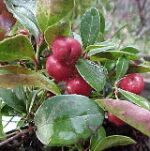| Common Name: |
Partridge Berry |
| Other Names: |
Boxberry, Canada Tea, Checkerberry, Deerberry, Hillberry, Mountain Tea, Spiceberry, Spring Wintergreen, Teaberry, Waxberry, Wintergreen |
| Botanical Name: |
Gaultheria procumbens |
| Genus: |
Gaultheria |
| Family: |
Ericaceae |
| Cultivation: |
Moist, peaty, neutral to acid soil in partial shade. |
| Propagation: |
By seed sown in autumn on soil surface; by semi-ripe cuttings in summer; by separation of rooted suckers in spring. |
| Harvest: |
Leaves are gathered from spring to early autumn and dried for use in infusions and liquid extracts. Oil is extracted from fresh leaves for use in rubbing oils, inhalants, liniments, and ointments. Fruits are picked when ripe. |
| Native Location: |
Eastern N America. |
| Height: |
7-15cm (3-6in) |
| Width: |
1m (3ft) |
| Hardiness: |
Z3-7 |
| History: |
Wintergreen is another of the plant kingdom's herbs that contains salicylates, the natural aspirin-like substances that relieve pain and inflammations. Specifically, wintergreen contains methyl salicylate, a compound that gives the herb a distinctive menthol aroma and minty taste. Methyl salicylate is now widely synthesized and used in an array of commercial products, including gargles, gums, mouthwashes, toothpastes, and that famously "hot" muscle ointment Ben-Gay™. Centuries ago, Native Americans used wintergreen tea for aches and pains, asthma, coughs, muscle and joint injuries, rheumatism, sore throats, stomach upsets, and toothaches. The early American colonists enthusiastically adopted the practice of drinking wintergreen (which was listed as an official medicine in the U.S. Pharmacopoeia until 1994) and used it as a substitute for the more expensive and much-taxed British teas. |
| Parts Used: |
Leaves, oil, fruits |
| Properties: |
An astringent, aromatic, warming herb that is anti-inflammatory, diuretic, and expectorant. It is a good antiseptic and counter-irritant. |
| Medicinal Uses: |
Mainly externally for rheumatism, arthritis, sciatica, myalgia, sprains, neuralgia, and mucus. Oil of wintergreen is toxic in excess, causing liver and kidney damage. Not given to patients with hypersensitivity to aspirin (salicylates).
To treat sciatica and other nerve ailments, menstrual problems, rheumatoid arthritis, asthma, and pleurisy.
Wintergreen has anti-inflammatory, astringent, diuretic, expectorant, pain-relieving, stomach-soothing, stimulant, and tonic properties. It is taken internally for pain and inflammations, and to treat arthritis, asthma, colds, colitis, coughs, joint, and tissue injuries, muscle spasms and sprains, rheumatism, and urinary tract ailments. Wintergreen is applied externally—in washes or ointments—to relieve pain and to treat minor skin ailments and inflammations. |
| Preparation: |
Wintergreen is available as dried herb and in capsules, oils, teas, and tinctures. To make a tea, pour 1 cup of boiling water over 1 teaspoon of dried herb and steep for 5 minutes. Strain, and drink up to 1 cup a day, 2 tablespoons at a time. |
| Caution: |
Do not give wintergreen to children under 16 if they have cold, flu, or other viral symptoms. The menthol salicylate in the herb may cause Reye's syndrome, a potentially fatal illness. Do not take wintergreen with other salicylates, such as aspirin, meadowsweet, or white willow because of the risk of additive effects. Wintergreen oil may irritate the skin. Use with caution. Do not ingest wintergreen oil. |
| Possible Side Effects: |
Wintergreen's side effects include lack of appetite, lethargy, and gastrointestinal irritation. |
| Drug Interactions: |
| Taking wintergreen with these drugs may cause or increase kidney damage: |
| Etodolac, (Lodine, Utradol) |
Ibuprofen, (Advil, Motrin) |
Indomethacin, (Indocin, Novo-Methacin) |
Ketoprofen, (Orudis, Rhodis) |
Ketorolac, (Acular, Toradol) |
| Meloxicam, (MOBIC, Mobicox) |
Metformin, (Glucophage, Riomet) |
Methotrexate, (Rheumatrex, Trexall) |
Miglitol, (Glyset) |
Morphine Hydrochloride, (Morphine Hydrochloride) |
| Morphine Sulfate, (Kadian, MS Contin) |
Naproxen, (Aleve, Naprosyn) |
Nitrofurantoin, (Furadantin, Macrobid) |
Ofloxacin, (Floxin, Ocuflox) |
Penicillin, (Pfizerpen, Wycillin) |
| Piroxicam, (Feldene, Nu-Pirox) |
Propoxyphene, (Darvon, Darvon-N) |
Rifampin, (Rifadin, Rimactane) |
Stavudine, (Zerit) |
Sucralfate, (Carafate, Sulcrate) |
| Tramadol, (Ultram) |
Valacyclovir, (Valtrex) |
Valganciclovir, (Valcyte) |
Vancomycin, (Vancocin) |
Zidovudine, (Novo-AZT, Retrovir) |
| Taking wintergreen with these drugs may increase the risk of bleeding or bruising: |
| Aminosalicylic Acid, (Nemasol Sodium, Paser) |
Antithrombin III, (Thrombate III) |
Argatroban, (Argatroban) |
Aspirin, (Bufferin, Ecotrin) |
| Bivalirudin, (Angiomax) |
Choline Magnesium Trisalicylate, (Trilisate) |
Choline Salicylate, (Teejel) |
Dalteparin, (Fragmin) |
| Danaparoid, (Orgaran) |
Enoxaparin, (Lovenox) |
Fondaparinux, (Arixtra) |
Heparin, (Hepalean, Hep-Lock) |
| Lepirudin, (Refludan) |
Salsalate, (Amgesic, Salflex) |
Tinzaparin, (Innohep) |
Warfarin, (Coumadin, Jantoven) |
|
| Disease Effects: |
- May worsen gastrointestinal irritation or inflammatory diseases.
- Wintergreen oil may trigger salicylate allergies or other allergic reactions.
|
| Culinary Uses: |
Leaves are used for tea, known as "mountain tea". Fruits are eaten raw or cooked in pies, or preserved as jam, jelly, or syrup. |
| Economic Uses: |
Oil is used to flavor root beer, chewing gum, and toothpaste; also in perfumery with woody notes. |
| Bibliography: |
Encyclopedia of Herbs by Deni Bown. Copyright © 1995, 2001 Dorling Kindersley Limited. pg 221
The Essential Herb-Drug-Vitamin Interaction Guide by Geo. T. Grossberg,MD and Barry Fox,PhD Copyright©2007 Barry Fox,PhD. Pp.492-493
The Modern Herbal Primer by Nancy Burke Copyright©2000 Yankee Publishing, Inc. pg 129
|

